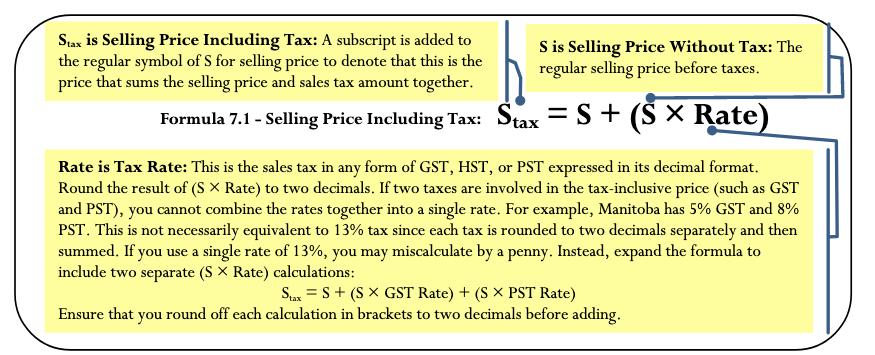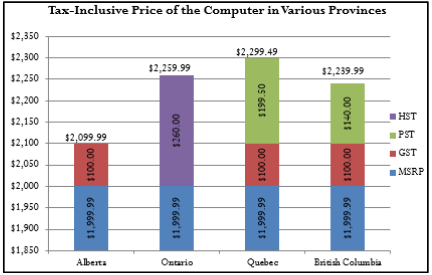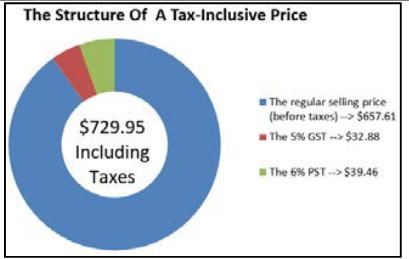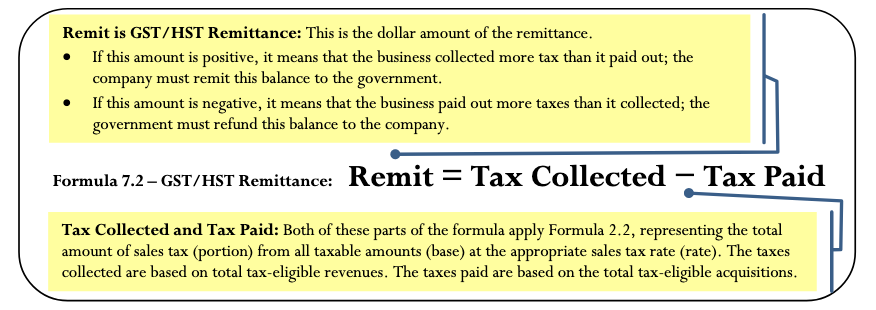4.1 Sales Taxes
Everybody Wants a Piece of My Pie
On your recent cross-Canada road trip, you purchased from many different Tim Hortons’ stores. At each store, your products retailed for $6.99. When you review your credit card receipts after returning home from your trip, you notice that you paid different totals everywhere. In Alberta, they only added GST and your combo cost $7.34. In British Columbia, they added both PST and GST, resulting in total cost of $7.83. In Ontario, they added something called HST, resulting in a total cost of $7.90. You find it interesting that the same combo came to different totals as you travelled across Canada.
Three Sales Taxes
A sales tax is a percent fee levied by a government on the supply of products. In Canada, there are three types of sales taxes: the goods and services tax (GST), provincial sales tax (PST), and the harmonized sales tax (HST). In this section you will learn the characteristics of each of these taxes and then the mathematics for calculating any sales tax.
Goods & Services Tax (GST)
The goods and services tax, better known as GST, is a national federal tax of 5% that applies to the purchase of most goods and services in Canada. Every province and territory has GST. The consumer ultimately bears the burden of this sales tax.
Businesses must collect GST on most of their sales and pay GST on most purchases in the daily course of operations. However, when remitting these taxes, businesses claim a credit with the federal government to recover the GST they paid on eligible purchases. The net result is that businesses do not pay the GST on these eligible purchases. While this may outrage some people, the logic is simple. If a business pays the GST, it becomes a cost of the business, which is then passed on to consumers as it is incorporated into retail prices. When the consumer purchases the product, the consumer would be charged the GST again! In essence, a consumer would be double-taxed on all purchases if businesses paid the GST.
Some goods and services are exempt from GST. While there are many complexities and nuances to the exemptions, generally items that are deemed necessities (such as basic groceries), essential services (such as health, legal aid, and childcare), and charitable activities are nontaxable. You can find a complete listing of exemptions on the Canada Revenue Agency website.
Provincial Sales Tax (PST)
Provincial sales taxes, or PST, are provincially administered sales taxes that are determined by each individual provincial or territorial government in Canada. The table here lists the current PST rates in Canada.
| Province / Territory | PST |
| Alberta | 0% |
| British Columbia | 7% |
| Manitoba | 8% |
| Northwest Territories | 0% |
| Nunavut | 0% |
| Quebec | 9.975% |
| Saskatchewan | 5% |
| Yukon Territory | 0% |
Similar to GST, PST applies to the purchase of most goods and services in the province, and consumers bear the burden. For the same reasons as with GST, businesses typically pay the PST on purchases for non-resale items (such as equipment and machinery) and do not pay the PST on resale items. Businesses are responsible for collecting PST on sales and remitting the tax to the provincial government. Individual provincial websites list the items and services that are exempt from PST.
Harmonized Sales Tax (HST)
The harmonized sales tax, or HST, is a combination of GST and PST into a single number. Since most goods and services are subjected to both taxes anyway, HST offers a simpler method of collecting and remitting the sales tax—a business has to collect and remit only one tax instead of two. Because there are pros and cons to HST, not all provinces use this method of collection, as summarized in the table below.
| Pros | Cons |
| Items that are previously PST payable to a business are now refunded, lowering input costs and lowering consumer prices | Many items such as utilities, services, and children’s clothing that are ineligible for PST become taxed at the full HST rate |
| Results in overall lower corporate taxes paid | Consumer cost of living increases |
| Increases the competitiveness of businesses and results in job creation | Tax-exempt items see prices rise because HST is being applied to services and goods such as transportation and gasoline |
| Businesses only remit one tax and not two, resulting in financial and auditing savings |
| Province / Territory | HST |
| Ontario | 13% |
| New Brunswick | 13% |
| Nova Scotia | 14% |
| Newfoundland and Labrador | 13% |
| Prince Edward Island | 14% |
To understand HST you can separate it into its GST and PST components. For example, in the table to the left Ontario has an HST of 13%. If GST is 5% and the HST is 13%, then it is clear that the province has a PST of 8%. HST operates mostly in the same manner as GST, in that consumers generally bear the burden for paying this tax, and businesses both collect and pay the HST but have the HST reimbursed on eligible purchases when remitting taxes to the government.
The Formula
With respect to sales taxes, you usually calculate two things:
- The dollar amount of the sales tax.
- The price of a product including the sales tax.
Calculating the Sales Tax Amount
A sales tax is a percent rate calculated on the base selling price of the product. Therefore, if you are interested solely in the amount of the sales tax (the portion owing), apply Formula 2.2 on Rate, Portion, base:
![]()
Rearranging this formula to solve for the tax amount gives the following:
Tax Amount = Tax Rate × Price before Taxes (which is the same as Portion = Rate × Base)
This is not a new formula. It applies the existing formula from Chapter 2.
Calculating a Price Including Tax
When calculating a selling price including the tax, you take the regular selling price and increase it by the sales tax percentage.
![]()
The Old price is the price before taxes, the percent change is the sales tax percentage, and you need to calculate the New price including the tax. Rearranging the formula for New, you have
![]()
which you factor and rewrite as
![]()
or
![]()
This is a widespread application of the percent change formula.

How It Works
Follow these steps to perform calculations involving sales taxes:
Step 1: Identify the pricing information. In particular, pay careful attention to distinguish whether the price is before taxes (S)or inclusive of taxes (Stax). Also identify all applicable sales taxes, including GST, PST, and HST.
Step 2: Apply Formula 7.1 to solve for the unknown variable.
Step 3: If you need to find sales tax amounts, apply Formula 2.2 and rearrange for portion. Ensure that for the base you use the price before taxes.
Assume a $549.99 product is sold in British Columbia. Calculate the amount of the sales taxes and the price including the sales taxes.
Step 1: The price before taxes is S = $549.99. In British Columbia, GST is 5% and PST is 7% (from the PST Table).
Step 2: To calculate the price including the sales taxes, apply Formula 7.1:
Stax = $549.99 + ($549.99 × 5%) + ($549.99 × 7%) = $615.99
Step 3: Applying the rearranged Formula 2.2 for the GST, you calculate:
GST Tax Amount = 5% × $549.99 = $27.50
Applying the same formula for the PST, you calculate:
PST Tax Amount = 7% × $549.99 = $38.50.
Therefore, on a $549.99 item in British Columbia, $27.50 in GST and $38.50 in PST are owing, resulting in a price including sales taxes of $615.99.
Important Notes
To calculate a price including a single sales tax rate, use the percent change function (∆%) on the calculator. You can review the full instructions for this function at the end of Chapter 3. When using this function, OLD is the price before taxes, NEW is the price after taxes, and %CH is the single tax rate in its percentage format. You do not use the #PD variable, which therefore defaults to 1.
Note that if more than one tax rate applies on the same base, sum the tax rates together and enter as the percent change (or use as Rate in the formula). However, note that due to the penny rounding on the individual taxes, an error margin of a single penny may occur when trying to make S plus the taxes equal to Stax. This may be an unavoidable error and it would remain impossible to exactly equal the price including the sales tax.
Paths To Success
You will often need to manipulate Formula 7.1. Most of the time, prices are advertised without taxes and you need to calculate the price including the taxes. However, sometimes prices are advertised including the taxes and you must calculate the original price of the product before taxes. When only one tax is involved, this poses no problem, but when two taxes are involved (GST and PST), combine the taxes into a single amount before you solve for S.
Give It Some Thought
On any given product selling for the same price, put the following provinces in order from highest price to lowest price including taxes (GST and PST, or HST): Alberta, Saskatchewan, British Columbia, Ontario, Prince Edward Island.
Solutions
Example 7.1 A: Calculating Sales tax Across Canada
Dell Canada lists a complete computer system on its Canadian website for $1,999.99. Calculate the price including taxes if the Canadian buyer is located in: a. Alberta c. Quebec b. Ontario d. British Columbia (BC ).
Plan
Four answers are required. For each of the provinces listed, calculate the appropriate GST/PST or HST to add onto the price and arrive at the selling price including taxes (Stax).
What You Already Know
Step 1: The price of the computer and tax
rates are known:
- S = $1,999.99
- Alberta sales tax = 5% GST
- Ontario sales tax = 13% HST
- Quebec sales tax = 5% GST & 9.975% PST
- BC sales tax = 5% GST & 7% PST
How Will You Get There
Step 2: For all provinces, apply Formula 7.1.
a. For Alberta, the Rate is the 5% GST. Substitute the S and Rate to solve for Stax.
b. For Ontario, the Rate is the 13% HST. Substitute the S and Rate to solve for Stax.
c. For Quebec, both the 5% GST and 9.975% PST are based on the S. Expand the formula for each tax. Substitute these Rates with the S to arrive at Stax.
d. d. For British Columbia, both the 5% GST and 7% PST are based on the S. Expand the formula for each tax. Substitute these Rates with the S to arrive at Stax.
Perform
Step 2:
a. Alberta: Stax = $1,999.99 + ($1,999.99 × 5%) = $2,099.99
b. Ontario: Stax = $1,999.99 + ($1,999.99 × 13%) = $2,259.99
c. Quebec: Stax = $1,999.99 + ($1,999.99 × 5%) + ($1,999.99 × 9.975%) = $2,299.49
d. d. British Columbia: Stax = $1,999.99 + ($1,999.99 × 5%) + ($1,999.99 × 7%) =$2,239.99
Present
Depending on which province you reside in, the price for the computer from lowest to highest is Alberta at $2,099.99, British Columbia at $2,239.99, Ontario at $2,259.99, and Quebec at $2,299.49.

Example 7.1 B Calculating Taxes on a Tax–Inclusive Price
“The Brick is having its Midnight Madness sale! Pay no taxes on products purchased during this event!” While this is good marketing, it probably goes without saying that governments do not give up the sales taxes. Essentially The Brick is advertising a tax-inclusive price. Calculate GST and PST amounts for a product advertised at $729.95, including GST and PST, in Saskatchewan.
Plan
To calculate the PST and GST for Saskatchewan, you must calculate the price before taxes (S). Then calculate each tax amount based on the S.
What You Already Know
Step 1: The price after taxes and the tax rates are as follows:
- Stax = $729.95
- Tax rates = 5% GST and 6% PST
How Will You Get There
Step 2: Apply Formula 7.1 using the combined PST and GST as the Rate to calculate the S.
Step 3: Apply Formula 2.2 rearranged for Portion to calculate the tax amounts.
Perform
Step 2: Remove the taxes:
- $729.95 = S + (S × 11%)
- $729.95 = 1.11S
- S = $657.61
Step 3:
- GST: 5% = GST Portion ÷ $657.61;
- GST Portion = $32.88 PST: 6% = PST Portion ÷ $657.61;
- PST Portion = $39.46
Present

When paying a tax-inclusive price of $729.95 in Saskatchewan, the regular selling price of the item is $657.61 with $ $32.88 GST and $39.46 PST included.
The GST/HST Remittance
When a business collects sales taxes, it is a go-between in the transaction. These sales tax monies do not belong to the business. On a regular basis, the business must forward this money to the government. This payment is known as a tax remittance.
The Formula
Generally speaking, a business does not pay sales taxes. As a result, the government permits a business to take all eligible sales taxes that it paid through its acquisitions and net them against all sales taxes collected from sales. The end result is that the business is reimbursed for any eligible out-of -pocket sales tax that it paid. Formula 7.2 expresses this relationship.
Formula 7.2

How It Works
Follow these steps to complete a GST/HST remittance:
Step 1: Identify the total amounts of tax-eligible revenues and acquisitions upon which the sales tax is collected or paid, respectively. Identify the applicable sales tax rate of the GST or HST.
Step 2: Calculate the total taxes collected by applying Formula 2.2, where the sales tax is the rate and the total revenue is the base. Solve for portion.
Step 3: Calculate the total taxes paid by applying Formula 2.2, where the sales tax is the rate and the total acquisitions are the base. Solve for portion.
Step 4: Apply Formula 7.2 to calculate the tax remittance.
Example
Assume a business has paid GST on purchases of $153,000. It has also collected GST on sales of $358,440. Calculate the GST remittance.
Step 1: Identifying the variables, you have:
Total Revenue = $358,440
Total Acquisitions = $153,000
GST Tax Rate = 5%
Step 2: Calculate taxes collected by applying Formula 2.2, where:
GST collected = 5% × $358,440 = $17,922.
Step 3: Calculate taxes paid by applying Formula 2.2, where:
GST paid = 5% × $153,000 = $7,650.
Step 4: To calculate the remittance, apply Formula 7.2 and calculate Remit = $17,922 − $7,650 = $10,272. The business should remit a cheque for $10,272 to the government.
Paths To Success
A shortcut can help you calculate the GST/HST. Remittance using Formula 7.2. If you do not need to know the actual amounts of the tax paid and collected, you can net GST/HST–eligible revenues minus acquisitions and multiply the difference by the tax rate:
Remit = (Revenues − Acquisitions) × Rate
In the example above, Remit = ($358,440 – $153,000) x 5% = $10,272. If this calculation produces a negative number, then the business receives a refund instead of making a remittance.
Example 7.1 C Calculating a GST/HST Remittance
An Albertan lumber company reported the following quarterly purchases and sales in its 2013 operating year:
Assuming all purchases and sales are eligible and subject to GST, calculate the GST remittance or refund for each quarter.
Plan
Calculate the GST tax remittance, or Tax Remit, for each of the quarters.
What You Already Know
Step 1: From the information provided, the total purchases and sales for each quarter along with the GST = 5%, which is the Tax Rate, are known.
How Will You Get There
Step 2: For each quarter, calculate the GST collected by rearranging and applying Formula 2.2.
Step 3: Calculate the tax paid.
Step 4: Apply Formula 7.2 for each quarter
Perform
| Step 2 | Step 3 | Step 4 | |||
| Quarter | Sales | GST Collected (Sales x 5%) | Purchases | GST Paid (Purchases x 5%) | Remittance (Tax Collected – Tax Paid) |
| Winter | $911,500 | $45,575 | $1,316,000 | $65,800 | $45,575 – $65,800 = – $20,225 |
| Spring | $1,475,300 | $73,650 | $1,266,200 | $63,310 | $73,650 – $63,310 = – $10,340 |
| Summer | $1,381,700 | $69,085 | $1,053,700 | $52,685 | $69,085 – $52,685 = – $16,400 |
| Fall | $1,124,600 | $56,230 | $878,100 | $43,905 | $56,230 – $43,905 = – $12,325 |
Present
In the Winter quarter, the company gets a GST refund of $20,225. In the other three quarters, the company remits to the government payments of $10,340, $16,400, and $12,325, respectively.
Exercises
Mechanics
- You are purchasing a new BlackBerry at the MSRP of $649.99. Calculate the price including taxes in the following provinces or territories:
a)Northwest Territories
b)New Brunswick
c)Nova Scotia
d)British Columbia - The Brick is advertising a new Serta mattress nationally for a price of $899.99 including taxes. What is the price before taxes and the sales tax amounts in each of the following provinces?
a)Ontario
b)Saskatchewan - Audiophonic Electronics is calculating its HST remittance in Prince Edward Island. For each of the following months, calculate the HST remittance or refund on these HST-eligible amounts.
Month Purchases Sales January $48,693 $94,288 February $71,997 $53,639 - Airwaves Mobility is calculating its GST remittance in Alberta. For each of the following quarters, calculate the GST remittance or refund on these GST-eligible amounts.
Quarter Purchases Sales Winter $123,698 $267,122 Spring $179,410 $158,905 Summer $216,045 $412,111 Fall $198,836 $175,003
Applications
- Elena lives in Nova Scotia and has relatives in Alberta, Saskatchewan, and Quebec. She gets together with them often. She wants to purchase a new aerobic trainer and would like to pay the lowest price. If a family member buys the item, Elena can pick it up at one of their regular family gatherings. The price of the trainer for each province is listed below:
New Aerobic Trainer Prices per Province Province Selling Price Nova Scotia $1,229.50 Alberta $1,329.95 Saskatchewan $1,274.25 Quebec $1,219.75
-
-
- Where should Elena have the aerobic trainer purchased and how much would she pay?
- How much money would she save from her most expensive option?
-
- Mary Lou just purchased a new digital camera in Nunavut for $556.49 including taxes. What was the price of the camera before taxes? What amount of sales tax is paid?
- Marley is at Peoples Jewellers in New Brunswick wanting to purchase an engagement ring for his girlfriend. The price of the ring is $2,699.95. If the credit limit on his credit card is $3,000, will he be able to purchase the ring on his credit card? If not, what is the minimum amount of cash that he must put down to use his credit card?
- In the IKEA store in Vancouver, British Columbia, you are considering the purchase of a set of kitchen cabinets priced at $3,997.59. Calculate the amount of GST and PST you must pay for the cabinets, along with the total price including taxes.
- A company in Saskatchewan recorded the following GST-eligible purchases and sales throughout the year. Determine the GST remittance or refund per quarter.
Quarter Purchases Sales 1st $2,164,700 $2,522,000 2nd $1,571,300 $2,278,700 3rd $1,816,100 $1,654,000 4th $2,395,900 $1,911,700
- A manufacturer in Nova Scotia recorded the following HST-eligible purchases and sales in its first three months of its fiscal year. Determine the HST remittance or refund per month.
Month Purchases Sales March $20,209 $26,550 April $28,861 $20,480 May $22,649 $42,340
Challenge, Critical Thinking, & Other Applications
- 15. If the selling price of an item is 6% higher in Yukon than in Ontario, will the price including taxes be higher in Yukon or Ontario? What percentage more?
- Colin just travelled across the country on a road trip. He bought some skis in Alberta for $879.95 plus tax, a boombox in British Columbia for $145.58 including taxes, a Niagara Falls souvenir in Ontario for $99.97 plus tax, and some maple syrup in Quebec for $45.14 including tax. Overall, how much GST, PST, and HST did Colin pay on his trip?
- 17. Cisco Enterprises in Ontario purchased the following in a single month:
• 16,000 units of network routers at $79.25 each, priced at $97.97 each
• 12,000 units of wireless LAN adapters at $129.95 each, priced at $189.55 each
• 13,500 units of computer boards at $229.15 each, priced at $369.50 each.
Assuming that all units purchased are sold during the same month and that all purchases and sales are taxable, calculate the tax remittance or refund for the month. - In Quebec, the PST used to be calculated on the price including GST. When the PST was calculated in this manner, what PST rate did Quebec set to arrive at the same price including taxes?
- For each of the following situations, compute the selling price of the product before taxes in the other province/territory that would result in the same selling price including taxes as the item listed.
Price Before Tax Sold In Find Equivalent Price a. $365.75 British Columbia Prince Edward Island b. $1,795.00 Alberta Manitoba c. $19,995.95 Saskatchewan Ontario d. $4,819.35 New Brunswick Quesbec - A company made the following taxable transactions in a single month. Compute the GST remittance on its operations assuming all sales and purchases are eligible for GST
Transaction Type Unit Type Quantity Purchase $168.70 5,430 Sale $130.00 4,000 Sale $148.39 3,600 Purchase $93.47 2,950 Purchase $24.23 3,325 Purchase $121.20 2,770 Sale $188.88 6,250

